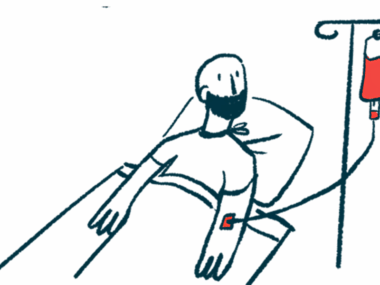My Quest to Name the Beast That Is MG
Written by |

With a prevalence of 14-40 cases per 100,000 people in the U.S., myasthenia gravis (MG) is considered a rare disease. Plus, early-onset MG can mimic other diseases like multiple sclerosis, amyotrophic lateral sclerosis, and others.
If a patient is one of the “lucky” ones who has autoantibodies indicative of the disease, confirmation of a diagnosis can be as easy as a blood test. But when those tests come back negative, those of us who are seronegative or sero-unknown — meaning such antibodies are insufficient to be detected — are like unicorns in a herd of zebras. Our diagnosis comes with much trial, tribulation, and years of frustration.
Unicorns, zebras, and horses, oh my!
Why zebras and not horses? Medical students are familiar with a saying often used in their education: “When you hear hoofbeats, think horses, not zebras.” This is why the zebra stripe pattern is used to symbolize rare diseases — people with a rare disease are like a horse of a different color. And it’s why those of us with atypical presentations of these rare diseases feel like unicorns — we’re rare, even among the rare.
The quest begins
My quest to name the beast that was stealing my life began while I was enlisted in the U.S. Army as a combat medic. While deployed to Iraq in 2010, I began having seizures, tremors, unexplained weakness, brain fog, and other issues. Much of it was chalked up to stress, described as psychological in nature, or blamed on conversion disorder (now referred to as functional neurological disorder). While doctors offered various theories about what could have caused all this, actual answers eluded me.
Then, after my medical retirement from the Army in July 2011, the symptoms of MG began to appear, starting with leg weakness.
In April 2012, I began experiencing bilateral leg weakness to the point of requiring mobility aids, including a cane, forearm crutches, and sometimes a wheelchair. I was 28 years old and felt like this beast, whatever it was, was taking my life away.
As time went on, I had neuropsychological evaluations that measured my IQ and cognitive function. I also was referred to psychiatric care and prescribed anxiety and depression meds. I developed dysphagia (difficulty swallowing), dysarthria (difficulty speaking), vision problems including double vision, difficulty breathing, and generalized weakness.
By 30, I was taking 30 pills a day for a variety of ailments and symptoms. My doctors at the time were more concerned about treating the symptoms than finding out if they were related. Eventually, I took matters into my own hands and started doing my own research and asking more questions at every appointment.
In July 2017, I was hospitalized after losing 10 pounds in less than a week from choking on my food and experiencing air hunger, which is a primal urge to breathe. This was also the year I saw an ophthalmologist at a Veterans Affairs (VA) clinic because I had begun to have ptosis (eye drooping).
The beast has a name
That month, I finally received a working diagnosis of myasthenia gravis. The ophthalmologist suggested it as a likely diagnosis that would explain many of the other issues I’d been having.
I asked to try the medication Mestinon (pyridostigmine) to help manage my symptoms, but my neurologist at the VA insisted I first be evaluated by a psychologist specializing in diagnosing conversion disorder.
The conversion disorder speculation was negative, so I began taking Mestinon, which provided some relief. In 2018, seven years after descending the rabbit hole in search of the beast that was causing my symptoms, I finally had a name for it: myasthenia gravis.
I was difficult to diagnose for several reasons. First, my clinical presentation and symptoms progression were atypical. As a rule, legs are typically not the first muscle group to weaken under MG. Second, I tested negative for all known antibodies, so diagnosis had to be made based on clinical presentation and symptom improvement while taking medications. Third, the VA’s overworked doctors have a high caseload and often don’t have time to stay up to date on the most current research for rare diseases. And fourth, I also have a PTSD diagnosis, so symptoms often were blamed on that.
It’s been a long journey to reach a diagnosis, but the sacrifices I’ve made have been worth it. Along the way, I’ve learned many lessons that I can’t wait to share with you all in upcoming columns.
What was your diagnosis journey like? Please share in the comments below.
Note: Myasthenia Gravis News is strictly a news and information website about the disease. It does not provide medical advice, diagnosis or treatment. This content is not intended to be a substitute for professional medical advice, diagnosis, or treatment. Always seek the advice of your physician or other qualified health provider with any questions you may have regarding a medical condition. Never disregard professional medical advice or delay in seeking it because of something you have read on this website.







john koch
I had diffically swallowing and I could not tell my wife what was wrong. She thought I was having a stroke and rushed to the local hospital.For six days and lots of tests------ct scans mri lots of blood tests I was sent to a Neurologist and he gave me a diagnosis YOU Have myasthenia gravis.That was 5/7 2019. i am pretty well controlled with one Mestinon tablet three times a day and 2 mycophenolate sandoz tablet in the morning and 1 tablet at night. I thank GOD that my symptons are so mild compared to all the stories in the forum.JOHN KOCH
Shawna Barnes
Thank you for sharing John!
Jonathan D AUTORE
I had the same problems and all the same symptoms as you had. But it took forever to get a name for my disease .... but I guess that I was LUCKY. I was MAD AS HELL, that it took me 8 months to have a name ACUTE OCULAR and GENERALIZED MYASTHENIA GRAVIS. Every doctor, including two neurologists, an eye doctor, and a neurosurgeon,at the first hospital, was CLUELESS. They had apparently never been taught about MG in med school. They called me a "A POOR HISTORIAN" .. they could not believe one disease could have 8 or 9 symptoms. I finally found "MY ANGEL" ... a floor nurse at St. Joseph's who recognized my symptoms .... "I KNOW EXACTLY WHAT YOU HAVE ... WE HAVE PATIENTS RIGHT HERE AT ST. JOSEPH's THAT HAVE ALL YOUR SYMPTOMS ... YOU HAVE MG" . She got me tested, IVIGed, and put on MESTINON, CELLECEPT, and that supernasty PREDNISONE ... that along with ATORVASTATIN, gave me medically induced DIABETES II, acute INSOMNIA, and weight gain.
I feel so sorry that it took you so long to be diagnosed. But you were EXTREMELY LUCKY. You had an eye doctor that recognized MG. My eye doctor did not recognize severe ptosis and my other eye issues, so he did not refer me to a NEURO-OPTIMOLOGIST (sp ??), like the other MG patients that got a quick diagnosis
I have been in remission now .... after spending 5 months in 5 hospitals in 2020. Insufficiently educated doctors can be dangerous. Due to dangerous antibiotics and an overdosing of MRI/CAT SCAN sedation, the first hospital gave me acute respiratory failure , a collapsed right lung, three pneumonias (in less than 24-36 hours in ICU), a slit throat TRACH, and 4 months of total hearing and speech loss. I am so happy that floor nurse saved me and I have a name for my disease, now. I TOO, AM GETTING EDUCATED and joining MG support groups. Thanks for writing your story. It helps the rest of us.
Shawna Barnes
Thank you for sharing Jonathan. I think it is important for all of us to share our story since we are all different. It's important for not only patients but other medical providers to know that there are many of us that don't present like what's given in a textbook. I'm happy to see that you are doing well now.
Jan A McAlindon
I was diagnosed in 2017 by a neuro-opthamologist because of terrible double vision.and have had a myriad of confusion since then culminating in them now saying I probably don't have MG but have a conversion disorder. I have progressed from just double vision and sporadic weakness to being intubated 5 times - (respiratory arrest, hypoxia), last year with ever increasing weakness, fatigue. I am terrible confused. I have in the past been treated with pyridostigmine, Cellcept, IVIG, plasmapheresis. steroids. in varying degrees and dosages. The symptoms wax and wane, some days Im great and some I cant even breathe properly. They diagnosed me with seronegative generalized MG and the meds work until they dont. I am scared to death that they will stop treating me for MG and my breathing fail and no one listens. The Neurologist at the hospital ER noted he thought I was malingering last time I was there which is terribly hurtful and yes I was intubated after he saw me, He said not myasthenia treatment just steroids and monitoring in the ICU. THEN the second Neurologist had them give me IVIG because in his words "It works" I dont know where to turn.
Anon
Thank you for writing about this Shawna. I am 27 years old and going through exactly this right now, and this has given me hope. All I want is to feel better and get my life back - my mental health is the best it has ever been, but doctors at the hospital immediately dismissed my symptoms as psychiatric when the blood test for the usual antibodies of MG was negative. Absolutely no talk of testing for MuSK or anything like that, just immediately dismissed me after 12 days of hospitalization. I still can’t walk, lift my arms, use my hands for more than 20 minutes at a time, and have terrible eye strain and heaviness that is impacting my ability to live my life and work normally. I have an EMG scheduled soon and hope that will offer some answers, but no clue what will happen to me if it’s negative. This whole experience has been so demoralizing, confusing, and frustrating. Thank you for sharing your experience, I’m so glad you were eventually able to get the help and treatment you needed.